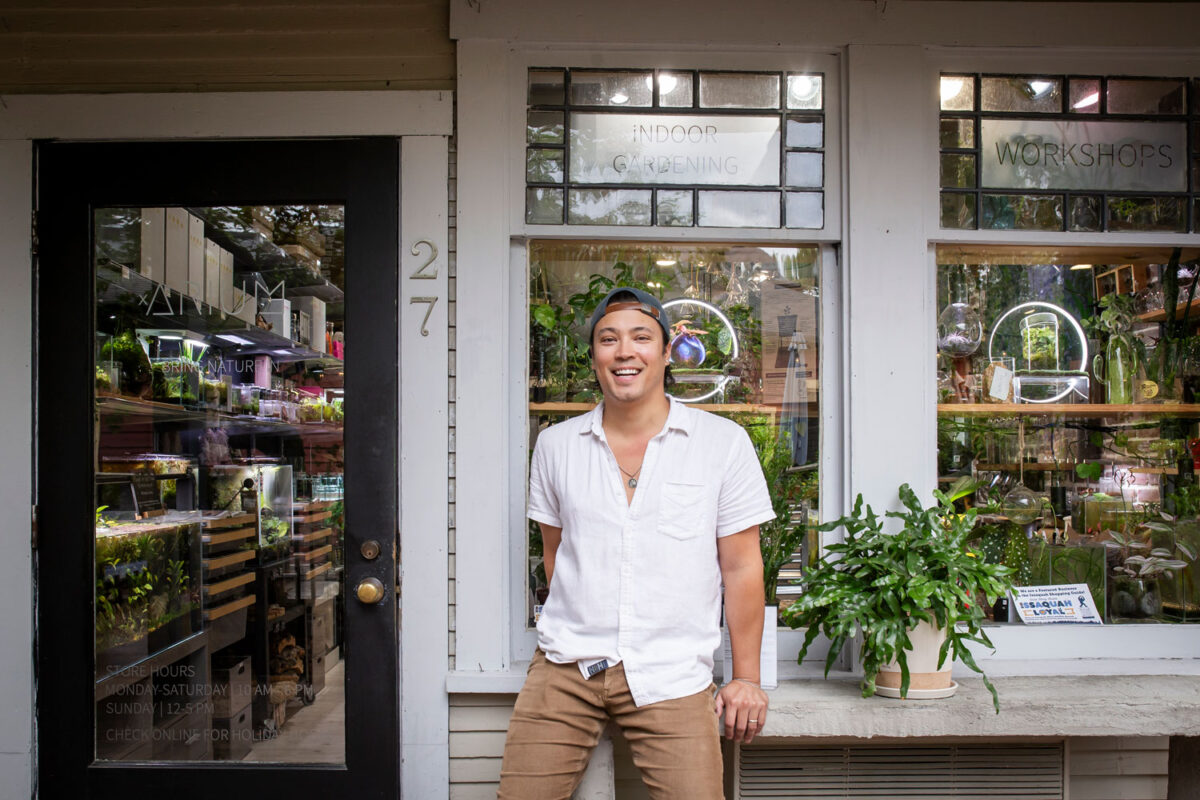Students Luis Contreras and Virkamal Dhaliwal in lab with Associate Professor Lori Robins (photo by Marc Studer)

By Douglas Esser
A University of Washington Bothell chemistry professor and two of her students share in the credit for a potential breakthrough in preventing dementia disorders such as mad cow disease and Alzheimer’s.
They contributed to research published in the journal PLOS Pathogens that found the HOCl or hypochlorous acid produced by the Briotech company of Woodinville destroys prions, the abnormally folded proteins behind many neurological diseases.
Research conducted for the National Institutes of Health (NIH) at the Rocky Mountain Laboratories, a National Institute of Allergy and Infectious Diseases lab in Hamilton, Montana, confirmed the results in mice.
“The scientists determined that BrioHOCl eliminated all detectible prion seeding activity for CJD (Creutzfeldt-Jakob disease), bovine spongiform encephalopathy (BSE or mad cow disease), chronic wasting disease (a disease primarily found in deer, elk and moose) and scrapie (a disease of sheep) in brain homogenates,” NIH said in a media alert.
BrioHOCl had similar effects on proteins thought to be toxic in Parkinson ’s disease and Alzheimer’s, the NIH said.
Important data for the research was provided by Lori Robins, associate professor in the School of Science, Technology, Engineering & Mathematics at UW Bothell, and the two students. They performed chemical analysis at the University and also used Raman spectroscopy instrumentation at the Molecular Engineering and Sciences Institute at the UW in Seattle where they were aided by Micah Glaz.
Their part of the work was quantification to show BrioHOCl is stable and pure. “And we proved that in your lab,” said Dan Terry, Briotech founder and CEO. “The University of Washington Bothell helped validate why we’re special.”
HOCl, which takes its name from its molecular makeup of hydrogen, oxygen and chlorine, mimics the body’s own immune cell chemistry to kill bacteria, viruses and fungi. It is manufactured by putting a brine solution through a patented electrolysis technology.
Robins, the chemistry professor, says it’s a weak acid form of bleach, which gives it a slight chlorine smell like a swimming pool. It’s harmless to touch and harmless even if sprayed in the eye.
What makes BrioHOCl so promising is that prions are nearly impossible to eliminate by heat, radiation or harsh chemical decontamination.
“Nothing whacks ‘em except our stuff,” says Jeff Williams, chief scientific officer for Briotech. “We are accomplishing on an industrial scale something that happens in every body as a first line of defense,” Williams said.
Williams, co-founder of the Bothell water purification company HaloSource, was a member of UW Bothell’s STEM advisory board and brought the Briotech work to the University.
In the late summer of 2015, Robins started two students, Virkamal Dhaliwal and Luis Contreras, working for Briotech on HOCl. They analyzed its purity and how long it remains effective.
“We have the characterization on our end that allows them to make the claim that it’s HOCl in the solution that’s doing the activity,” Robins says.
The efficacy of the Briotech product is particularly interesting in light of research that suggests neurological diseases, including Alzheimer’s, could be spread by prions on medical devices such as probes.
“A red-hot issue is Alzheimer’s being transmitted on medical instruments,” said Williams.
BrioHOCl could be used to clean such probes with a quick, simple immersion or perhaps even a spray.
“I think for the medical field it’s a big development because it can sterilize without ruining medical devices,” Robins says.
The findings so far open up new avenues of research in the relationship of HOCl and preventing dementia as well as the studying the effect of BrioHOCl on pathogens that threaten global health and safety, Williams and Terry say.
The paper in the current issue of PLOS Pathogens has more than a dozen authors, including the NIAID senior investigator Byron Caughey, Williams, Robins and her two students.
“We and NIH think those students merit authorship on the paper,” Williams said. “It’s a very big deal.”
They contributed some really important analytical chemistry, says Williams. “To get a couple of young people – recent grads – to get to the point of having their names on a paper that will have international renown is pretty significant.”
Dhaliwal and Contreras, who both graduated in 2015 in biology, worked for Briotech before continuing their education in health research.
Contreras, whose family came from a small town in Mexico, says he never imagined graduating from a university or being a co-author on a paper.
“This opportunity has been amazing in terms of the learning experience as well as working with different individuals,” he says.
Dhaliwal, who has a younger brother with a neurological disorder, says she’s always wanted to help and to have a career in science, research and medicine. She wanted “to be able to contribute something and be able to make an impact in a field so relevant to my own life and upbringing.”
The UW Bothell researchers contributed to something the world is going to hear about, says Williams who had a 27-year career as a microbiology professor at Michigan State University. More recently, he’s started another chemical technology company, OxiScience, in Bellevue, which also involves some of Robins’ students.
Williams said, “We have taken advantage of bright young people and facilities on our doorstep.”
UW Bothell is deeply engaged in partnerships, says Elaine Scott, dean of the UW Bothell School of STEM.
“Like many businesses in this biotech corridor, Briotech was able to take advantage of the research and analysis skills of our students, graduates and faculty. Our team pushed beyond the challenge and learned additional skills outside the classroom that were vital to the research. The results, validated by NIH, will pay in dividends for generations to come,” Scott said.



